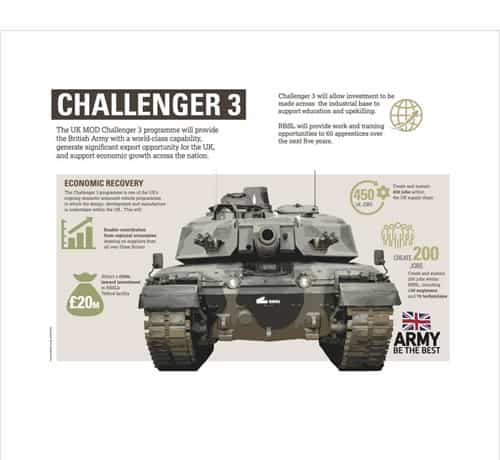There’s a new kid in town
Challenger 3 (CR3) is the next generation British main battle tank in development for the British Army. It will be produced by conversion of existing Challenger 2 tanks by the British/German Rheinmetall BAE Systems Land joint venture (RBSL).
Planned improvements to Challenger 2 began in 2005 as the Capability And Sustainment Program (CSP) to keep the Challenger 2 competitive until the 2030s. Lack of funding meant that it wasn’t until 2014 that the program was formally reorganised into the “Challenger 2 Life Extension Program” (LEP).
In response to the LEP program, two prototypes were submitted for evaluation; one from BAE Systems in 2018 and the other from Rheinmetall in 2019. Later that year BAE and Rheinmetall merged their British operations into Rheinmetall BAE Systems Land (RBSL), effectively leaving Rheinmetall’s proposal the only option available without replacing the Challenger 2 fleet with non-indigenous models.
The Challenger 3 will be the fourth tank that has born the name Challenger. The first was the Second World War Cruiser Mk VIII Challenger, which was developed from the Cromwell tank chassis and armed with a QF 17-pounder gun, and was issued to the 8th King’s Royal Irish Hussars in Northwest Europe 1944-45. The second was the Cold War-era Challenger 1. An improved Chieftain turret with a new hull, engine, transmission and suspension. First issued to the Regiment in 1986 and saw service in Germany, the 1st Gulf War, Bosnia, Canada, Poland and the UK. It was succeeded in 1999 by the Challenger 2 which has been the workhorse of the Regiment to today. It has seen service with the Regiment in Germany, Iraq, Canada, Poland, Estonia, Kosovo and the UK. Significant technical and digital breakthroughs over the past decade and evolving new threats on the battlefield meant a new platform was required.
The Challenger 3 has an all-new turret with an improved hull. The most significant change from Challenger 2 to Challenger 3 is the replacement of the Challenger’s main armament from a 120mm L30A1 Rifled main gun to the 120mm L55A1 smoothbore gun (which itself is an upgraded version of the L55 fitted to the Leopard 2A6/A7 family of main battle tanks) giving commonality of ammunition with other NATO members.
The first production models should be completed in 2025.


